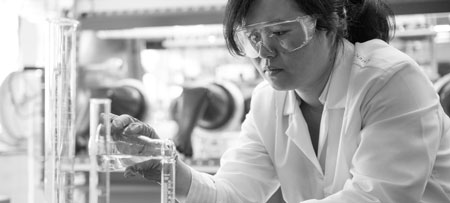Technical Capabilities at Your Finger Tips
You can take your work at Argonne through the entire R&D pipeline. It is your one-stop shop for technical innovation.
Discovery
Argonne has a suite of world-leading tools to image and characterize material structures, mechanical properties, and chemical compositions and interactions at levels beyond the technical reach of most industry and academic laboratories.
Innovators can gain insights that include nanometer spatial resolution, picosecond temporal resolution, micro- to macro-level 3-D imaging at interfaces, and characterization under real-world operating conditions. These insights help innovators quickly identify defects and contaminations, optimize material properties, and develop new catalysis methods.
Argonne Researchers
Argonne research scientists act as mentors and principal investigators for CRI startups. Researcher List
Predictive Modeling
Innovators can predict material behaviors with high accuracy by using high-performance computing at the Argonne Leadership Computing Facility and the supercomputer Mira to assess material properties under varying conditions.
Predictive modeling can reduce the time it takes to design technology and enable the creation of reduced-order models that manufacturers can run on laptops to allow for real-time quality assessment and pivoting of manufacturing processes during fabrication and scale-up stages. Predictive modeling also enables the building of techno-economic models used to assess the viability of markets and predict product performances and costs during scale-up through commercialization.
The Mathematics and Computer Science Division also produces next-generation technologies and software to tackle challenges of big data collected from sensors, simulations and databases to provide the best predictive modeling for use in advanced manufacturing systems and infrastructure monitoring tools for activities such as efficiently integrating renewable energies onto the grid.
Synthesis and Fabrication
To optimize performance, reduce the use of rare earth materials, and minimize waste, innovators can design customized materials tailored to specific uses. Argonne’s Center for Nanoscale Materials provides thin-film deposition, material synthesis, and semiconductor processing tools, along with a fully-equipped clean room.
For energy storage research, Argonne’s Cell Analysis, Modeling and Prototyping (CAMP) Facility is a climate-controlled lab that allows scientists to manufacture, for their own use, full-size prototype battery cells (both pouch and 18650 cells) and battery electrodes.
For materials development, the high throughput research laboratory provides automated and parallel approaches to synthesize and screen large numbers of compounds to optimize their reaction or process conditions 10 to 100x faster than conventional approaches.
Scale-up and Performance Testing
To ensure that technologies are safe and reliable and can be manufactured economically at scale, innovators can use Argonne’s Materials Engineering Research Facility (MERF). At MERF, innovators can test laboratory-developed materials at scale-up levels and validate emerging manufacturing processes.
Examples of research tools for select research areas
NUCLEAR:
CLIMATE RESILIENCE:
- Combatting Climate Change – Argonne delivers science and technology solutions that build a clean energy economy, mitigate climate change, and create resilient communities
- Center for Climate Resilience and Decision Science brings together over 20 years of applied decision science with world-class climate science for immediate, actionable climate resilience solutions
- Climate Risk and Resilience Portal empowers individuals, governments, and organizations to examine simulated future climate conditions at mid- and end-of-century for a range of climate perils.
TRANSPORTATION:
- Transportation Research and Analysis Computing Center uses the U.S. Department of Transportation’s largest HPC cluster to conduct modeling, simulation and visualization work to assess and reduce failure risks and for virtual prototype testing.
- Center for Transportation Research provides innovative solutions to challenges involving fuel efficiency, emissions, durability, safety, design and operating efficiency, petroleum dependence, interoperability, compatibility and codes/standards compliance and harmonization.
- Engine Research Facility allows scientists and engineers to study in-cylinder combustion and emissions under realistic operating conditions. The facility’s engines range in size from automobile- to locomotive-sized, as well as stationary electric power production engines.
- Heat Transfer Laboratory allows the study of materials in solids or fluid forms, which play an important role in a wide range of mechanical systems and vehicle cooling applications. Understanding how materials behave when subjected to anticipated thermal conditions is critical to increasing their performance range and longevity.
- Tribology Laboratory enables research on advanced tribological systems (surface engineered materials, lubricants, fuels, and fuel/lubricant additives) for use in aggressive environments (for example, where two surfaces are rubbing together). The laboratory is equipped with a full range of coating development, friction/wear testing and characterization facilities.
- Transportation Beamline at the Advanced Photon Source allows researchers to use the powerful X-ray beams created by the APS to penetrate materials and reveal details that cannot otherwise be seen. Transportation researchers use this tool to peer inside liquid sprays from fuel injectors for diesel engines.
- EV-Smart Grid Interoperability Center offers state-of-the art tools to advance charging interoperability and global harmonization for electric vehicles.
- Center for Energy, Environmental, and Economic Systems Analysis has innovative Argonne-developed methodologies, systems, technologies, and analytical tools useful for analysis of energy, environmental, and economic systems, facilitating credible, defensible decisions regarding large-scale deployment.
ENERGY STORAGE:
- Cell Analysis, Modeling and Prototyping (CAMP) facility is used to design, fabricate, and characterize high-quality prototype cells.
- The Materials and Modeling Support (M&MS) group is a multidisciplinary group of scientists and engineers focused on developing a better understanding of electrode design, their components, and its effect on electrochemical performance.
- Materials Engineering Research Facility (MERF) enables the development of manufacturing processes for producing advanced battery materials in sufficient quantity for industrial testing.
- Battery Post-Test facility enables the dissection, harvesting and analyzing of battery materials from used and previously tested battery cells in order to identify for developers and manufacturers the exact mechanisms that limit the life of their battery cells. The lab can handle cells up to 300 Ah, while other facilities like this are typically limited to about 1-2 Ah.
- Joint Center for Energy Storage
- Advanced Photon Source uses X-rays to nanoscale to bulk analysis for battery material development and testing.
- Electrochemical Analysis and Diagnostics Laboratory provides battery and fuel cell developers with reliable, independent, and unbiased performance evaluations of their cells, modules, and battery packs.
ENVIRONMENTAL AND BIOSCIENCE:
- Institute for Genomics & Systems Biology provides access to R&D facilities for analyze, screening and computation to look at microbial cycling of carbon, topsoil systems, and metagenomics to monitor the impact of pollutants and to improve clean up of contaminated environments.
- Advanced Protein Characterization Facility offers researchers the most advanced technologies for studying new classes of proteins and protein complexes.




